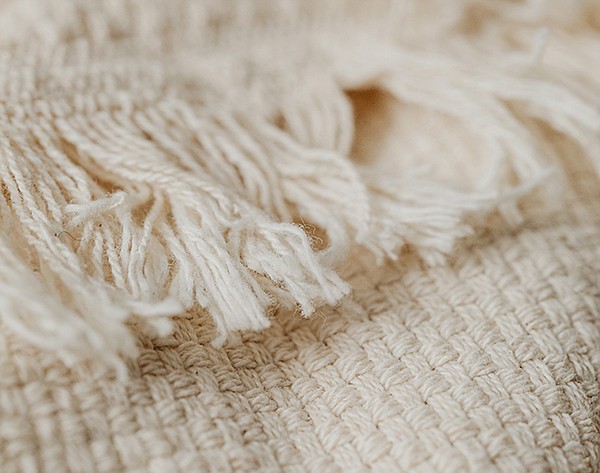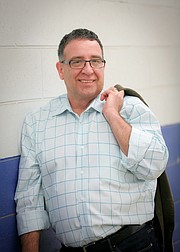TEXTILES
Industry Focus: Textiles, Fiber & Yarn - Textile Experts Weigh In on Sustainability and Circularity, Transparency and Accountability
At the foundation of every garment is a choice regarding fabrication. This commitment to a certain textile that relies on specific fibers helps to tell the story of a collection. From the early days of design and conceptualization to the arrival of finished apparel in stores or on a customer’s doorstep, fabrics define how a piece of clothing will be received during each step along the production process, in addition to how they will be received once released on the runway, to buyers at trade events and, ultimately, to the public.
While the heritage of quality and classic elements in textiles is enduring—transcending generations and seasonal style shifts—even the most venerable names in fabrics recognize the most important changing trends. Whether these changes occur in fiber, hand feel, texture or sourcing, they can help determine the direction of the industry.
With the second half of 2022 soon entering cooler months, the promise of a new year with fresh ideas in fashion can be seen on the horizon. California Apparel News asked experts in fiber, yarn and fabrics: As designers and brands plan their 2023 collections, what trend in textiles is strongest and will make the most impact during the upcoming seasons?
Ramin Daneshgar
Sales Manager
Cinergy Textiles
At Cinergy Textiles, we know that supply chain is a challenge for our customers, and our strong, low-minimum, in-stock programs are key to this pain point so that they can react to immediate demand.
We are responding to a specific demand for solid fabrics, though prints and novelties are still showing traction. Our recent focus is stocking fabrics that are 100 percent cotton or cotton blends in the lawn, gauze, poplin, twill and jersey categories. Stripes and herringbones will also be very popular, and we specialize in cotton chambrays, linen blends and rayon-challis fabrications.
Nelson Jaffery
Assistant Vice President of Design
Birla Cellulose
As we find ourselves in the recovery phase of the COVID pandemic, though the transition is a process, it is a chance for us to take responsibility and create consciousness. We know that changes are needed in the way we consume, manufacture and develop ideas about future growth.
In 2023, consumers will be hungry for products that restore a sense of well-being and want evolved-staple wardrobe items that are more versatile and create continuity across seasons and collections. The search for longevity and sustainability continues with a stronger purpose, with responsible fashion changing the game and designers leading the way.
While options in recycled, regenerated and closed-loop fabrics are more in demand than ever, good design is key, where products and processes are sustainable, long term and traceable. Brands are working toward adapting to changing lifestyles, and textiles are used in creative and unexpected ways to bridge that gap.
The immersive qualities of both nature and technology will influence new otherworldly aesthetics, where dreamy digital worlds, twilight colors, bioluminescent ocean life and barren Mars-like landscapes inspire exciting new designs.
Joy will be treated as an active ingredient in the products—not as a novelty but as a way to bring positivity into the everyday. Minimalist designs will be coupled with a sense of fun as creativity is aligned with a greater sense of purpose. Uncertainty and discovery will be embraced as necessary sparks in the design process.
In this era of intentional creativity, designers will work collaboratively to make simpler and smarter products and services. Meaningful, nurturing and thoughtful design driven by the appeal of home and nature will be of prime focus.
We will see demand for flexible, multipurpose and “go anywhere” products that are made for—or inspired by—nomadic lifestyles, both traditional and contemporary.
Ron Kaufman
Sales Manager and Director of Product Development
Robert Kaufman Fabrics
Sustainability, sustainability, sustainability! We are working with our mills to offer more fabrics made with organic and BCI cotton, hemp, recycled synthetics as well as Tencel, cupro and other options. Also gaining in popularity, there will be more fabric customization using digital printing and other methods to help brands create smaller collections and experiment with new concepts. Performance aspects like stretch and recovery, wicking and UV protection remain an important requirement with customers.
Yves Klinger
Product Manager
KBC Fashion
Sustainability, reliability and proximity are the key words for KBC. Sustainable fabrics are a major part of our offerings. The range of prints originate from cellulose, including linens and cottons of timeless resonance, bringing sensuality and cheerfulness to summer. The appeal of the material has led designers to the roughness of textures—the imperfection of patterns in BCI cotton or certified GOTS, the sense of handmade linen structures and vibrant recycled polyester. The eco-responsible approach is handled quite literally; the archives consulted give rise to new plant interpretations.
The colors sparkle while calling upon tranquility and quietude. Mid-tone greens emerge as an eye-catching color. Lavender tones continue to trend up. Energizing red combinations with hyper pink are the rising colors. Connected to sustainable values and to natural elements, blue shades suggest relaxing moments. Sophisticated dark shades of brown become as basic as unbleached white shades. The subtle art of the print is in the new collections proposed—tie-dye, retro, bohemian, cashmere, tropical—oriented toward naturalness, optimism, softness and lightness with that special KBC twist.
Hoi Kwan Lam
Executive Vice President and Chief Marketing Officer
HeiQ
There are two trends that I am seeing and would like to highlight. Number 1 is circularity—it’s all about raw materials and the end-of-life destiny of textiles. We’ve created continuous cellulosic yarns like HeiQ AeoniQ as a climate-positive, continuous-cellulose-filament yarn. Our proprietary manufacturing process can reproduce properties of polyester and nylon yarns that are currently not achievable by other cellulosic yarns. Made of sustainable raw materials such as circulose, sustainably managed forests, algae, bacteria or cellulose extracted from preconsumer waste or end-of-life textiles, each ton of HeiQ AeoniQ can potentially enable five tons of CO2 emission reduction. Textiles made of HeiQ AeoniQ do not consume any agricultural land, pesticides or fertilizers.
About recyclability, the topic of textile recycling has only been around for less than 10 years. HeiQ AeoniQ is fully biodegradable and designed for circularity. HeiQ AeoniQ yarns match synthetic fiber properties and are designed for closed-loop circularity while maintaining consistent fiber quality.
Number 2 is functionality. Millennials and Gen Z are reducing the number of items in their wardrobes in order to reduce all the environmental impact along the supply chain. But this may be economically not sustainable for some members in the value chain. By adding functionality to the garment, the value of each item can be increased. Higher willingness to pay from the consumer means a larger pie per item sold to be shared among all members in the value chain. And a multifunctional garment is definitely in line with the trend of reduced number of items because this means the consumer can use the same item for different occasions. Functionalities such as dynamic cooling, odor control, improved stretch and insect repellence are all in trend and can be simultaneously delivered by the same garment by adding textile finishings.
Michelle Lea
Vice President of Global Marketing
NILIT
Sustainability is the consumer megatrend that will continue to influence the apparel industry for decades to come. At NILIT, we have seen this strengthening as consumers learn more about the significant impact our industry can have on the planet. Our apparel partners who embrace this direction have joined us in designing apparel using more-sustainable materials and educating consumers about the responsible choices now available to them.
Along with considerate apparel selections, consumers are interested in learning more about the companies behind the products they buy. Today’s conscious consumers expect transparency, corporate responsibility and accountability so it is important for companies throughout the global apparel supply chain to present themselves honestly and ensure reliable information is available to consumers who seek it.
At NILIT, we have focused intently on this sustainability megatrend for many years now. In response to growing concerns about the planet’s health, we are accelerating initiatives to make nylon more sustainable, with a focus on manufacturing and product development. We published our corporate sustainability report last year and will soon release an update detailing our progress against stated goals, many of which we achieved well ahead of schedule.
We provide industry-leading premium Nylon 6.6 products that empower designers to create the responsible apparel their markets demand. Our most recent introduction, SENSIL ByNature, is a groundbreaking Nylon 6.6 that incorporates biomass ingredients made from reclaimed organic waste in place of fossil feedstocks. SENSIL ByNature instantly reduces apparel’s carbon footprint without giving up the performance, aesthetics or longevity for which SENSIL premium Nylon 6.6 is so well known. Companies who understand today’s conscious consumer know that quality is the first step toward a more sustainable apparel industry.
Cindy McNaull
Brand Business Development Director
CORDURA Advanced Fabrics
What we’re hearing most from our customers is that even though the economy appears to be contracting consumers are still willing to pay for differentiated, advanced fabric solutions—products that are built to last that offer multipurpose functionality.
At CORDURA Advanced Fabrics, we stand behind the importance of long-lasting products powered by performance-driven, durable fabrics. This resonates in the marketplace now more than ever, and we are continuing to partner with our valuable authorized mills, brand customers and designers to push the limits of durability for the consumer of today and tomorrow.
Celeste Ramsey
Manager Business Development North America
Trevira
Functionality and performance are two key words that highlight today’s expectations of apparel and fabrics. Designed to fulfill specific needs, customized yarns render an added value to fabrics, apparel and the wearer. Over the last few decades, garment evolution has accelerated, and the design spectrum has grown tremendously also as a result of yarn partners in the textile value-added supply chain, enabling mills to create bespoke, functional and appealing fabrics.
This development starts with the initial yarn producer. Indorama’s LifeStyle Business Unit represents the collaborative business of numerous Indorama Ventures Limited Group companies. Formed in 2020, it comprises 13 production sites in nine countries. Thanks to the fully integrated polyester production starting from polycondensation through to chips production, spinning, texturing, yarn dyeing, beaming and twisting, as well as the manufacturing of staple fibers, all production steps take place in-house. This strategy enables Indorama’s LifeStyle Team to offer global, solution-driven and customized products not only for apparel but also for the home and automotive-interior textiles industries.
From staple fibers to filament yarns, disperse dyeable polypropylene to low-melt polyester yarns, recycled to modified to recycled and modified polyester, solution dyed to in-house yarn-dyed yarn, section beaming to twisting, Indorama LifeStyle has a comprehensive product offering. The extensive yarn portfolio also includes PLA yarns manufactured from 100 percent renewable raw material, which is industrially compostable.
Moisture control for sportswear, odor-reduction yarns for activewear, and durable, sustainable and sophisticated yarns for high-end fashion and the woven-labels industry are but a few examples of Indorama LifeStyle’s offerings. With CoolVisions, customers benefit from a unique, disperse, dyeable polypropylene. CoolVisions is also one of the lightest of all commercial yarns, is fast drying and delivers excellent moisture-management properties while maintaining all of the inherent attributes of polypropylene.
Erica Redd
Business Development Manager
Lenzing Fibers Inc.
When we think of fashion trends, we often think of styles that may only last a season, which can be a detriment to sustainability. However, we love a trend that contributes to sustainability and circularity. The industry is seeing an increase in demand from consumers for brands to be more transparent and sustainable with their textiles. This includes raw materials that are traceable and, even better, circular. Across the industry, circularity is a trend that is not going away, especially as brands find fun and creative ways to communicate circularity through their marketing initiatives.
Some great examples of transparent marketing from 2022 are Timberland’s Luxe Comfort, Parade’s New:Cotton and Hanky Panky’s ECO Rx lines, all made with TENCEL x REFIBRA and with their own avant-garde marketing campaigns. The impact of a traceable raw material made with 30 percent upcycled cotton is high on those consumers’ lists who are actively seeking more-sustainable options and overall transparency from brands. Designers and brands should lean into the trend of sustainability and circularity to meet consumer demand while implementing more-sustainable products and communication. Helping the planet and making a positive impact on moving the industry toward more sustainable practices is a trend I can get behind!
David Sasso
President
DNY
We continue to see sustainability as a large trend across the apparel supply chain, and the fiber segment is no different. Soluble-fiber Solucell is designed to be used in a variety of textile applications. It is formulated to dissolve with simplicity, and it’s environmentally friendly and made with circularity in mind.
Typical applications in apparel yield improved softness and increased thermal functionality with lower weight. Spin limits for yarns are increased. In certain cases, cost reductions can be achieved. Functionality, hand feel and drape are enhanced without the use of chemicals, leaving the fabric natural and unbelievably comfortable.
Pierette Scavuzzo
Design Director
Cone Denim
Fabrics that tell a clear and transparent story will continue to be essential for 2023 collections. In denim, this has been important for years and has pushed the industry, be it textile or garment manufacturer, to do better and make investments to help brands and consumers attain these components.
One way Cone addresses transparency for all of its products on all platforms is by using Oritain cotton tracing, which is grounded in forensic science and ensures that none of the cotton used in our products is grown with unethical practices.
Another key pillar would be circularity and innovation within that space. To address this, we launched a Nothing Goes to Waste initiative, a call to action to inspire the design community and brands to use the Zero Waste philosophy. We designed a product capsule that utilizes 100 percent recycled fiber that comes in colors from sorting the fabric waste, which eliminates the need for an additional dye process. Another product capsule that captures this spirit is our Color Revive collection. Here we take our internal dye waste to create a yarn, eliminating a dye process and resulting in significant water and chemical reduction.
Kimberlee Schreiner
Founder
KMS Group LLC
For Fall/Winter 2023–24, the three key trends are innovation, disruption and comfort. The conversation around sustainability continues to evolve as fabric manufacturers have had time to assess their place in it over the last couple of years.
New innovations fall into three categories—new natural fibers, recycled fibers and science-based developments. The new natural materials can be found in sources like kapok, seaweed, nettle and banana fibers applied to knits, wovens and faux leather.
Recycled is another category of fabrics, that is expanding as manufacturers find new ways to break down synthetic and blended contents. Knits and wovens can now rely on agricultural waste and recycled post-consumer blends. Recycled cotton and plastic from previous years remain on our radar. Developments using bio-based technology to create new materials yield fabrics that are used for activewear and outerwear with the same high-performance properties of synthetics but are biodegradable or compostable.
The industry is already being disrupted through the introduction of these new innovations, which are forcing us to relearn approaches to materials, but you can also see it through new twists on traditional tailoring. Unexpected bright colors and patchwork break up plaid or stripe patterns and bring a new dimension to fabrics. You also see this in distorted prints with a digitized effect.
Comfort is an important trend for this season. We have been through a lot of change the past couple of years, so we all want to feel comforted and protected as we reemerge into daily life. This can be achieved through lofty fabrics like alpaca, cashmere or wool outerwear and thick-gauge sweater knits. Also, quilting techniques for outerwear are still important but are updated by using softer fill and different fabrics such as knits with brushed or peached finishes to create a pillow effect.
Mike Simko
Marketing Director, Textiles
Hyosung Global
After visiting six trade shows in the U.S. and Europe over the last two months, I would say that there is growing brand interest in bio-based materials. Brands are looking to develop deeper connections and trust with consumers concerned with how the products they love impact the environment. And they also want to be assured that these materials are backed by documented claims, they can pass along to sustain consumer loyalty.
As a sustainable-textile-solution provider, it’s very important for us to provide brands with the necessary support they need to tell these stories. This is one reason we certify our sustainable fibers. Our creora bio-based spandex recently received eco-product certification from the Swiss-based Standard Global Services, guaranteeing that the fiber is made with plant-based materials and is produced in a harmless and eco-friendly environment.
Creora bio-based spandex, which provides the same ultra-stretch quality and recovery as Hyosung’s creora Powerfit spandex, is made by replacing 30 percent of petroleum-based resources with bio-based raw materials derived from industrial field corn, or dent corn. According to a recent third-party LCA, the manufacture of creora bio-based spandex reduces its carbon footprint by 23 percent as compared to the production of regular spandex.
Additionally, the sustainably grown feedstock used to make the fiber is responsibly grown by farmers who target and measure their efforts to protect the land, air and water.
There will be technologies that will be commercialized over the next two to three years that will allow us to increase the bio-based content to at least 70 percent.
Deana Stankowski
Strategic Marketing Director
The LYCRA Company
As we look toward 2023, we see multiple trends impacting the industry. One key focus is adding functional performance benefits like cooling, warming and durability to garments. While there is much emphasis on the performance features of garments, consumers continue to place great value on comfort. The lingering effects of the global pandemic are driving consumers’ expectations that their clothing be as comfortable as it can be, providing ease of movement as they go about their day, whether at home, on the go or back at the office.
Offering sustainable solutions across all garment categories is also a growing source of innovation for us as the retailers and brands we work with are looking for long-lasting, lower-impact solutions. Our patent-pending LYCRA ADAPTIV fiber enables garments to adapt to changing body shapes and offer a wider fit window. LYCRA XTRA LIFE fiber resists damage from chlorine during that much-needed vacation, while LYCRA BLACK technology helps clothes maintain deep, rich colors and can help protect against sweat and sunscreen damage. These differentiated fiber solutions help garments stay in use longer.
Our EcoMade family of fibers spans our top three brands and are made with recycled content to reduce waste and a garment’s environmental impact. Our latest offerings are COOLMAX and THERMOLITE EcoMade fibers made from 100 percent textile waste, laying the groundwork for a circular system while addressing the desire for temperature comfort.
Katie Tague
Vice President of Denim Marketing and Sales
Artistic Milliners PVT LTD
While we’ve seen a rebound from the pandemic days, and the rise of trends like Y2K, we think in the upcoming year the pendulum will swing a little bit more back toward essentialism both in sustainability and versatility. Conscious consumerism isn’t just a trend anymore, and it’s in every aspect of the way we make our fabrics and garments.
This refined focus on essential products that consumers buy mostly what they need will also bleed into how their fashion looks, feels and is made. It needs to fit the way we live now—and flexibility is the main demand. With the launch of ArMill, we now offer non-denim woven and performance fabrics as well as our Artistic Milliners denim to keep up with this changing consumer. We are also focusing on less-treated fabrics, featuring recycled or natural fibers along with natural tints. We’re well equipped to fulfill this ask thanks to our class-leading proprietary fiber-recycling facility, Circular Park, as well as with our investment in waterless and chemical-free finishing and natural dyes.
Carolina Wilches
Senior Application Development Representative
Eastman Naia
I can see two main trends: celebration of life after COVID and sustainability as a key driver in fashion. Three years into COVID we now see new collections setting stage for clothing with materials and silhouettes representing fantasy, party and sparkle while at the same time shining the light on sustainability demanded by consumers.
These consumers want to know where the clothing is produced and what materials it’s made of. They have learned about recycling, biodegradability and the life span of a garment. The compositions of the clothing tend to be purer with no more than two or three different fibers used in one fabric. So fashion brands look for fibers that are highly versatile with a strong sustainability profile such as Eastman Naia cellulosic fiber, which can be blended with natural fibers like cotton and linen for summer and with warming fibers such as recycled wool for winter.
Sherry Wood
Director of Merchandising
Texollini
Texollini is making sustainability the new normal in the U.S. textile industry. We have positioned ourselves as a leading mill for high-performance fabrics for activewear, swimwear, athleisurewear and the intimate-apparel markets. The majority of our brands continue to adopt more-sustainable fibers in their collections, which encourages us to source new fibers from around the world. Our brands are leaders in the marketplace and need to be supported with the right fabrics at the right time because speed is key, and we have that advantage being in the U.S. Consumers today have expectations of performance and inclusivity from brands; they want their fabrics to perform for them.
When merchandising the new collections with sustainability and performance as the main themes, we want the fabrics to provide comfort, durability and longevity. The core of the collection for 2023 has many new recycled natural and synthetic fibers, including organic cotton, recycled cotton blends and wools. To round out the collection, we’ve added novelty stitches such as jacquards, ribs and ottomans. Blister knits, exaggerated raised-surface textures, micro-denier interlock knits, including styles that have been sueded or brushed, focus on color, either keeping with earth tones or going with bright, expressive, vibrant shades.
As wellness, work-life balance and the outdoors continue to dominate fabric design and innovation, knitwear continues to surge in the marketplace. Texollini has always looked to the future, which keeps us inspired and committed to offer more unique fabrics. As we consciously create new styles, we factor in all the trends of the moment, not only in the fabrics themselves but also in our fully vertical facility through modernization, which ultimately reduces our carbon footprint.
For more from industry leaders in the Fiber, Yarn and Textile community, see our. Industry Focus: Denim, from June 30, 2022
RELATED STORIES
- Industry Focus: Fiber, Yarn and Fabric—What features in fiber and yarn are your clients demanding, and how is this trend shaping the future of your business?
- Martex Acquires JBM Recycled Fibers
- Eastman’s Newest Cellulosic Blends Sustainability and Comfort in an Easy-Care Fiber
- Martex Acquires JBM Recycled Fibers







































